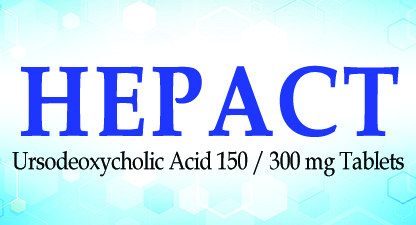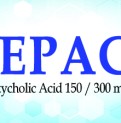HEPACT
UDCA (or Ursodiol) is a bile acid normally only found in small amounts in human bile. It is one of the secondary bile acids, which are metabolic byproducts of intestinal bacteria. Ursodeoxycholic Acid Tablets are used to dissolve gallstones that are rich in cholesterol. They can also be used to treat children, aged 6 years to less than 18 years, who have liver problems associated with cystic fibrosis.
- Categories : Hepatoprotective Agent
- Share Now :
HEPACT 150/300
Generic name: Ursodeoxycholic acid (UDCA)
Therapeutic Category: Anti-cholelithic
Pharmacological Class: Bile acids
Composition: Hepact 150
Each uncoated tablet contains Ursodeoxycholic acid BP 150 mg
Hepact 300
Each uncoated tablet contains Ursodeoxycholic acid BP 300 mg
Pregnancy Category: B
Presentation: Available in the pack size as 10tablets X 10 blisters
Mechanism of Action
Ursodeoxycholic acid reduces elevated liver enzyme levels by facilitating bile flow through the liver and protecting liver cells. The main mechanism if anticholelithic. Although the exact process of ursodiol's anticholelithic action is not completely understood, it is thought that the drug is concentrated in bile and decreases biliary cholesterol by suppressing hepatic synthesis and secretion of cholesterol and by inhibiting its intestinal absorption. The reduced cholesterol saturation permits the gradual solubilization of cholesterol from gallstones, resulting in their eventual dissolution.
Indications
- Gall stone dissolution
- Chronic Viral Hepatitis
- Primary Biliary Cirrhosis/Cholangitis
- Prevention of biliary pain
- Drug induced cholestasis
- Adult cholestatic liver disease
- Primary Sclerosing Cholangitis
- Intrahepatic Cholestasis of Pregnancy
Dosage
Route of administration: Oral
Primary Biliary Cirrhosis/Cholestatic liver diseases
Adults and Elderly:
10 - 15mg ursodeoxycholic acid (UDCA) per kg per day in two to four divided doses.
Children:
Dosage should be related to bodyweight.
Primary Sclerosing Cholangitis: 13-20 mg/kg per day
Dissolution of gallstones
Adults and Elderly:
The usual dose is 6 - 12mg/kg/day either as a single night time dose or in divided doses. This may be increased to 15mg/kg/day in obese patients, if necessary.
The duration of treatment may be up to two years, depending on the size of the stone(s), and should be continued for three months after the apparent dissolution of the stone(s).
Children: Dosage should be related to bodyweight.
Pharmacokinetics
Absorption: Absorbed from the small bowel (about 90% of dose)
Protein binding: High
Metabolism: Hepatic (first-pass hepatic clearance)
Time to peak concentration: 1 to 3 hours
Elimination: Primarily fecal; very small amounts are excreted into urine. Small amount of unabsorbed ursodiol passes into the colon where it undergoes bacterial degradation
Adverse Effects
- fever, chills, body aches, flu symptoms
- stomach pain, nausea, diarrhea, constipation
- dizziness, tired feeling
- back pain
- runny or stuffy nose, cold symptoms
- headache
Contraindications
HEPACT is contraindicated in the following populations and situations:
- With hypersensitivity to bile acids or any excipient of the formulation
- With radio-opaque calcified gall-stones,
- With acute inflammation of the gall bladder or biliary tract.
- With frequent episodes of biliary colic
- With impaired contractibility of the gall bladder
- With chronic liver disease, peptic ulcers or in those with inflammatory diseases of the small intestine and colon.
Drug Interactions
- Bile Acid Sequestering Agents: Reduces absorption of Hepact
- Aluminum-based Antacids
- Drugs Affecting Lipid Metabolism: Increase hepatic cholesterol secretion and encourage cholesterol gallstone formation and hence may counteract the effectiveness of Hepact.


